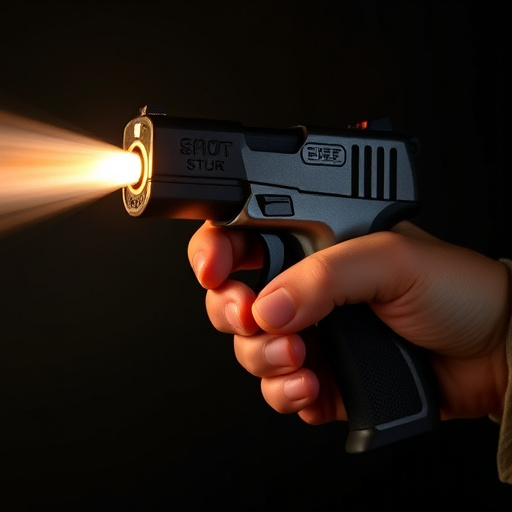The Hot Shot stun gun's performance relies heavily on its electrode spacing, which impacts current flow through targets. An ideal distance of 1-2 inches ensures maximum shock impact while minimizing energy waste and reducing internal damage risks. This advanced design prioritizes safety and efficacy, making the Hot Shot a preferred choice for self-defense, as optimal electrode spacing is crucial in various real-life scenarios.
“Uncover the critical aspect of stun gun electrode spacing—a key determinant of its effectiveness. This article explores the intricate balance between design and performance, focusing on the ‘Hot Shot Stun Gun’ and its unique features. We delve into factors influencing electrode performance, offering insights for optimal spacing. From understanding basic principles to best practices, this guide equips readers with knowledge to make informed decisions regarding stun gun choice and safety.”
- Understanding Stun Gun Electrode Spacing: The Basics
- Hot Shot Stun Gun: A Closer Look at Design and Effectiveness
- Factors Influencing Stun Gun Electrodes' Performance
- Best Practices for Optimal Stun Gun Electrode Spacing
Understanding Stun Gun Electrode Spacing: The Basics
Understanding Stun Gun Electrode Spacing: The Basics
When it comes to stun guns, particularly high-performance models like the hot shot stun gun, electrode spacing plays a crucial role in its effectiveness. Electrode spacing refers to the distance between the positive and negative electrodes within the device. This measurement is vital as it determines how well the stun gun can deliver an electric shock to neutralize a threat. Optimal electrode spacing ensures that the current flows efficiently through the target, disrupting their nervous system and immobilizing them temporarily.
For hot shot stun guns, a balanced and precise electrode spacing design allows for a strong jolt of electricity while minimizing energy waste. This efficiency is key to ensuring the stun gun can be relied upon in real-life self-defense scenarios. Proper spacing also contributes to the overall durability of the device, as it reduces the risk of internal damage due to excessive current flow.
Hot Shot Stun Gun: A Closer Look at Design and Effectiveness
The Hot Shot Stun Gun is a popular choice among those seeking personal protection, and its design plays a crucial role in its effectiveness. This stun gun features advanced electrode spacing, strategically placed to maximize shock delivery. The close proximity of the electrodes ensures that when activated, the current flows directly through the target, causing muscular paralysis and disorientation.
Each stun gun model, including the Hot Shot, undergoes rigorous testing to determine its power output and effectiveness. These tests measure the voltage, amperage, and pulse width delivered by the device, ensuring it meets safety standards while providing enough force to incapacitate an attacker temporarily. The Hot Shot Stun Gun’s design focuses on balance between power and control, making it a reliable tool for self-defense enthusiasts and professionals alike.
Factors Influencing Stun Gun Electrodes' Performance
The performance of a stun gun, like the Hot Shot Stun Gun, heavily relies on the spacing and arrangement of its electrodes. Several factors significantly influence the effectiveness of these electrodes during use. One key aspect is the distance between the electrodes; proper spacing ensures that a strong electrical current flows through the target’s body, leading to effective immobilization. Closer electrode spacing may enhance the impact but could also increase the risk of user injury or accidental shocks.
Additionally, the size and shape of the target play a crucial role. In the case of larger individuals, wider electrode spacing might be necessary to ensure thorough contact and current distribution. The environment and weather conditions can also affect performance; moisture, for instance, can conduct electricity, potentially altering the stun gun’s effectiveness. Understanding these variables is essential for optimal utilization of stun guns like the Hot Shot Stun Gun, ensuring both safety and efficacy during use.
Best Practices for Optimal Stun Gun Electrode Spacing
When it comes to using a hot shot stun gun, proper electrode spacing is paramount for maximizing effectiveness. For optimal results, maintain a distance of approximately 1-2 inches (2.5-5 cm) between the electrodes and the target area. This ensures a strong electric current flow, providing the best chance of incapacitating the subject quickly and safely.
Remember that consistent pressure and contact are key; keep both electrodes in direct contact with the targeted zone throughout the stun sequence. Proper training is essential to ensure you utilize the correct technique, minimizing risks while maximizing the stun gun’s effectiveness.
When it comes to choosing a stun gun, understanding electrode spacing is key. The Hot Shot Stun Gun, with its strategic design, offers optimal performance through precise electrode placement. By considering factors like body type and target area, users can ensure maximum effectiveness. Following best practices for stun gun electrode spacing, as outlined in this guide, will empower individuals to make informed decisions when selecting their self-defense tool, ultimately enhancing safety and peace of mind.
